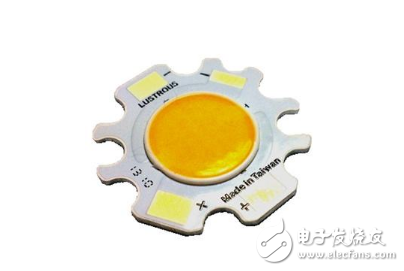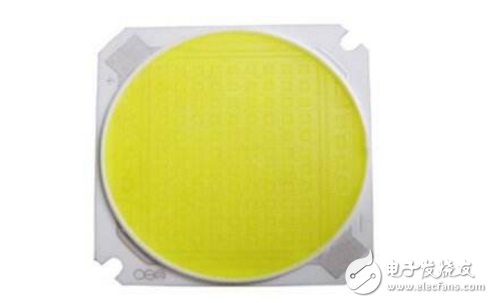LEDs are available in discrete and integrated packages. LED discrete devices are traditionally packaged and widely used in various related fields. After more than 40 years of development, a series of mainstream product forms have been formed. LED production equipment manufacturers for the traditional LED practices are: LED light source discrete devices → MCPCB light source module → LED lamps, mainly because there is no ready-made core light source components, not only time-consuming, but also costly.
Compared with discrete LED devices, COB light source modules can save LED's primary packaging cost, light engine module manufacturing cost and secondary light distribution cost in applications. In the lighting system with the same function, the actual measurement can reduce the cost of the light source by about 30%, which is of great significance for the application and promotion of semiconductor lighting. LED production equipment manufacturers through reasonable design and micro-lens molding, COB light source module can effectively avoid the disadvantages of spot light, glare, etc. in the combination of discrete light source devices; can also be achieved by adding appropriate red chip combination, without significantly reducing the efficiency of the light source and Under the premise of life, the color rendering of the light source is effectively improved.

In application, the COB light source module can make the installation and production of the lighting fixture factory simpler and more convenient, and effectively reduce the application cost. In production, existing process technologies and equipment can fully support the high-volume production of high-yield COB light source modules.
With the expansion of the LED lighting market, the demand for lamps is growing rapidly. LED production equipment manufacturers can gradually form a series of COB light source module mainstream products according to the needs of different lighting applications, so as to mass production.
Advantages and disadvantages of cob light sourceCOB integrated light source (Chip On Board), that is, the bare chip is adhered to the interconnect substrate with conductive or non-conductive glue, and then wire bonding is performed to realize electrical connection. The COB integrated light source is also called a COB planar light source.
The COB integrated light source is covered with a thermal conductive epoxy resin (usually an epoxy resin doped with silver particles) on the surface of the substrate, and the silicon wafer is directly placed on the surface of the substrate, and heat treated until the silicon wafer is firmly fixed on the substrate. Wire bonding is used to establish an electrical connection directly between the silicon wafer and the substrate. There are two main types of bare chip technology: one is COB technology and the other is flip chip technology (Flip Chip). Chip-on-board (COB), semiconductor chip is placed on the printed circuit board, and the electrical connection between the chip and the substrate is achieved by wire stitching. The electrical connection between the chip and the substrate is achieved by wire stitching and covered with resin to ensure reliability. . Although the COB integrated light source package is the simplest bare chip placement technology, its packaging density is far less than TAB and reverse chip bonding technology.
Generally speaking, COB light source is mainly used for indoor lighting. Its advantage is that the assembly process is relatively simple, the light plate is more uniform, but the heat dissipation is not as good as TOP. It can only be applied to the range of 3-50 watts. A little lower.
The advantage of the cob planar light source is that the divergence of the luminosity is large, and the light source area is relatively full. The disadvantage is that it consumes more power and is more troublesome to set up.

1, can be freely combined and combined to form a variety of LED lamps, easy to assemble. It can overcome the shortcomings of large size and high cost of the patch LED.
2, high reliability, no dead lights, no plaque. Its precision packaging process allows the chip to be fully dissipated to ensure the quality of the chip and extend its life.
3, even light, soft light, no glare, does not hurt the eyes. Being able to directly overcome the market is LED high-power dazzling. Shortcomings.
4, high color rendering index, high light efficiency. It can achieve 120lm/w and the illumination angle is above 120°. Cost savings, no need to do another PCB board, green and environmentally friendly, no pollution.
5. Under normal current, the attenuation is minimum, and the control is less than 3% within 1000H.
6, safe and reliable, all work below 50V, fully considered for the application of certification.
COB integrated light source has so many advantages, it has also been widely used in LED lighting, LED downlights, LED spotlights, LED ceiling lights and so on. It is one of the mainstream of LED lighting sources.

The advantages of ceramic planar light sources are as follows:
1. Ceramic planar light source module has high reliability. The ceramic and chip are all AL2O3 alumina materials. The expansion coefficient is similar, and the grain will not be soldered due to temperature changes, resulting in attenuation and dead light, which ensures the stability of the chip.
2. The thermal resistance is lower than 8, and the ceramic substrate of the ceramic planar light source is a high temperature sintered silver coating. The LED chip is directly packaged on the ceramic substrate, and the heat is directly conducted on the ceramic substrate, and the heat dissipation is fast.
3. The light-emitting surface is wide, the luminous efficiency is high, 110LM/W or more, the attenuation is small, and the light decay of 10000 hours is less than 2%.
4. The planar light source is an integrated light source module, which is easy to assemble and can be directly installed and used without considering other process design.
5. When the ceramic planar light source is working, the junction temperature of the phosphor and the silica gel can be controlled below 120 °C. The LED still works normally when the chip surface temperature is 80-90 degrees.
6. Withstand voltage above 4000V, high pressure and safety. It can match low current and high voltage non-isolated power supply, and can meet product export safety certification. Reduce power supply costs and improve power efficiency, thereby improving the light conversion efficiency of ceramic planar light sources.
7. Ceramic planar light source has strong ESD protection.
According to ISO 11801 C 2 Edition standards, T568A 568B wiring standars color code schema, communication speed reaches 10G+. it's your best choice to your high quality cabling solution.
Category 6A is one of the latest standards for networking performance approved by the TIA for twisted pair cables. We offer CAT6A Keystone Jack tested for transmission speeds of up to 500 MHz., making them suitable for 10G networks. At higher data speeds, the signal becomes increasingly vulnerable to electromagnetic interference (EMI). To combat this increased vulnerability, many of our CAT6A patch cables feature increased shielding and crosstalk prevention.
The performance of your 10G data network is only as strong as its strongest link. Reinforce your network with our CAT6A kesytone jack. CAT6A exhibits superior crosstalk prevention to handle noise at higher frequencies than CAT6 can handle. Our CAT6A booted Patch Cables have been speed tested to up to 600 MHz.
shielded kesytone jack, category 6a kesytone jack, 10G networking jack
NINGBO UONICORE ELECTRONICS CO., LTD , https://www.uniconmelectronics.com